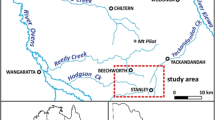Abstract
The Limpopo River Basin is underlain by an alluvial aquifer along the main river stem and fractured water-bearing units in tributary catchments. Notwithstanding that development priorities in parts of the basin in South Africa have historically preferred surface water sources for irrigation and domestic supply, water resources auditing suggests that groundwater presents the only viable alternative source of cost-effective supply to meet future requirements. However, while aquifer yields are favourable in places, averaging 16.7 l/s for main-stem alluvium, groundwater is already extensively used. Between 1995 and 2002, total groundwater use in the area rose by almost 40%, increasing from 98 to 136 million m3 per year. In all catchments, groundwater use grew by varying proportions, reaching a rather high 200% in the Mogalakwena catchment. In the particular case of commercial irrigation, over-exploitation of groundwater has been recorded in a number of places, especially in the northwest where drawdowns of more than 50 m have resulted from decades of intense agricultural water use. Although groundwater use for mining is still low at 4% of total usage in the study area, the region is currently witnessing a surge in mining operations, and a significant growth in water requirements is envisaged for mining development. Further, domestic water supply to the predominantly rural dwellers in the area is relatively low, even in terms of meeting the basic need of 25 l/day per person, underscoring the fact that groundwater will remain a critical source of community drinking water in the foreseeable future.



Similar content being viewed by others
References
Braune, E., & Dziembowski, Z. M. (1998). Rural groundwater supply development: Study on the supporting application of environmental isotopes, Northern Bochum District, Northern Province. Report No. GH 3908, Department of Water Affairs and Forestry, Pretoria.
Busari, O., & Jackson, B. (2005). South Africa’s Water and Sanitation Sector Reform: Progress and challenges. Proceedings, 31st WEDC International Conference, Kampala, pp. 109–114.
Du Toit, W. H. (2002). Update on groundwater use data in the Limpopo and Levuvhu/Letaba zwater management areas. Pretoria: Department of Water Affairs and Forestry.
Du Toit, W. H., Botha, F. S., & Goossens, H. H. (2000). Pontdrif/Weipe alluvial aquifer. Report No. GH 3958. Pretoria: Department of Water Affairs and Forestry.
DWAF (2003). Internal strategic perspective study: Limpopo water management area. Pretoria: Directorate for Water Resources Planning (North), Department of Water Affairs and Forestry.
DWAF (2004). National water resource strategy. Pretoria: Department of Water Affairs and Forestry.
Dziembowski, Z. M. (1976). The geohydrology of the dendron area, Pietersburg District. Report No. GH 2878. Pretoria: Department of Water Affairs and Forestry.
DWAF (2002). Limpopo water management area: Water resources situation assessment, Main report. Pretoria: Department of Water Affairs and Forestry.
GMKS (Pty) Ltd, Tlou and Matjie (Pty) Ltd, Golder Associates (Pty) Ltd, & Charles Sellick and Associates cc (2003). Development of internal strategic perspectives, WMAs 1–4: Limpopo ISP Draft Document (version 1). Draft Discussion Report. Pretoria: Department of Water Affairs and Forestry.
Government of Limpopo Province. (2002). Projects that use groundwater as a water source. Open File Report. Polokwane: Provincial Department of Agriculture.
Government of Limpopo Province. (2004). Provincial growth and development strategy: 2004–2014. Limpopo Province, Polokwane: Office of the Premier.
Government of Limpopo Province. (2006). About Limpopo—Provincial Economy and Investment. http://www.limpopo.gov.za/about_otp/prov_econ_invest.asp, accessed 26.06.2006.
Hubert, G. (2002). Internal strategic perspective, Limpopo water management area: Groundwater overview. Draft Discussion Report. Pretoria: Department of Water Affairs and Forestry.
Jolly, J. (1986). Borehole/irrigation survey and groundwater evaluation of the Doringlaagte drainage basin. Report No. GH 3495. Pretoria: Department of Water Affairs and Forestry.
Masiyandima, M., van der Stoep, I., Mwanasawani, T., & Pfupajena, S. C. (2001). Groundwater management strategies and their implications on irrigated agriculture: The case of dendron aquifer in Northern Province, South Africa. Proceedings, 2nd WARFSA/WaterNet Symposium, Cape Town, pp. 201–209.
Northern Transvaal Cooperative. (1990). Investigation of the groundwater resources in the dendron area (Doornlaagte catchment area) with a view to the development of a groundwater model. Agricultural Development Division.
Vegter, J. R. (1995). An explanation of a set of national groundwater maps. Report No. TT 74/95. Pretoria: Water Research Commission.
Vegter, J. R. (2001). Groundwater development in South Africa and an Introduction to the hydrogeology of groundwater regions. Report No. TT 134/00. Pretoria: Water Research Commission.
WSM/DWAF. (1995). Explanation of the 1:500 000 hydrogeological map, 2326 Pietersburg. Report No. TT 75/95. Pretoria: Water Research Commission.
Acknowledgements
Gratefully acknowledged are two key opportunities to work in the study area, the results of which this paper draws upon heavily. The one was a commissioned assignment undertaken for the International Water Management Institute (IWMI) on the occurrence and use of groundwater in the broader trans-boundary basin. The other, in full-time employment with the national Department of Water Affairs and Forestry (DWAF), was active professional participation and leadership in the process of developing an internal strategic perspective for the management of regional water resources.
Author information
Authors and Affiliations
Corresponding author
Additional information
Readers should send their comments on this paper to: BhaskarNath@aol.com within 3 months of publication of this issue.
Rights and permissions
About this article
Cite this article
Busari, O. Groundwater in the Limpopo Basin: occurrence, use and impact. Environ Dev Sustain 10, 943–957 (2008). https://doi.org/10.1007/s10668-007-9094-3
Received:
Accepted:
Published:
Issue Date:
DOI: https://doi.org/10.1007/s10668-007-9094-3




